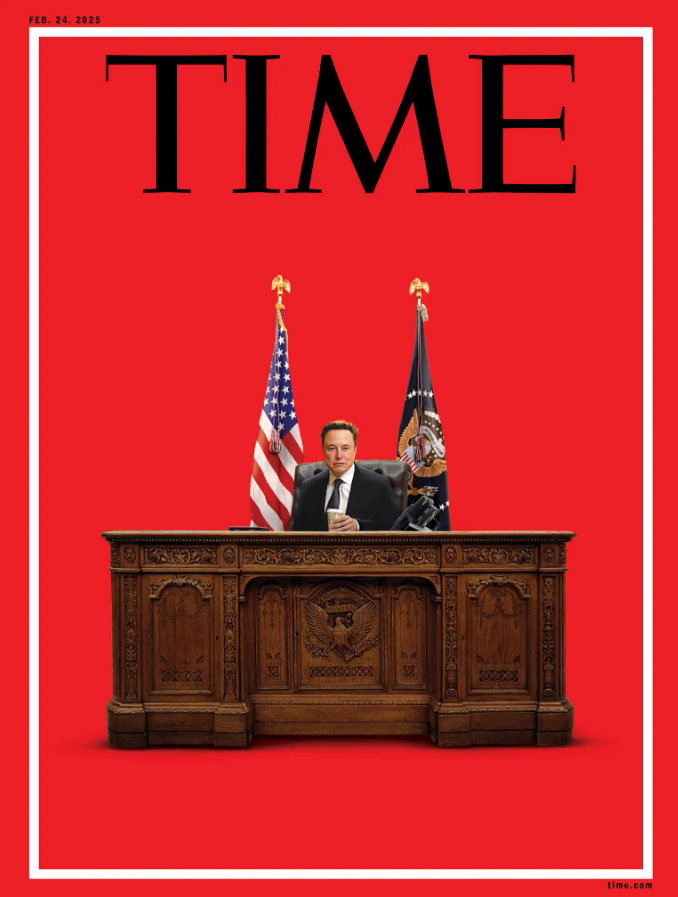In a striking and controversial move, TIME Magazine has once again captured the world’s attention with a provocative cover featuring Elon Musk, the billionaire CEO of Tesla and SpaceX, seated behind the Resolute Desk in the Oval Office. The imagery suggests an unparalleled level of influence that Musk holds over modern politics, particularly under Donald Trump’s administration. While Musk has never held public office, his expansive reach in technology, space exploration, artificial intelligence, and digital finance has positioned him as one of the most powerful private citizens in modern history. The cover immediately sparked a firestorm of reactions from the public, the media, and most notably, former President Donald Trump himself.
Elon Musk in the White House?
The cover of TIME is not just an artistic expression; it is a powerful statement about how corporate influence has seeped into governance. Musk, who has been deeply involved with government contracts through SpaceX, Neuralink, and Starlink, is now being viewed as a key player in reshaping federal policies. The image of him sitting confidently at the Resolute Desk symbolizes more than just corporate success—it signals the outsized power he holds within the U.S. government’s decision-making processes.
The cover story, published alongside this bold visual, delves into Musk’s expanding role in the current administration’s technological advancements, military strategies, and financial overhauls. Under Trump’s directive, Musk was reportedly tasked with leading efforts to streamline government agencies, particularly through his expertise in automation, artificial intelligence, and privatization. This has led to major shake-ups in federal departments, with Musk’s influence being described as nothing short of a silent takeover.
Trump’s Reaction: Dismissive or Calculated?
Upon seeing the cover, Donald Trump responded with characteristic bravado, dismissing the magazine’s impact entirely. “Is TIME Magazine still in business? I didn’t even know that,” he quipped during a press conference, prompting laughter from his supporters. However, this dismissive attitude did little to hide what many believe is a deep-rooted preoccupation Trump has with TIME Magazine and its covers.
Historically, Trump has been known to covet TIME’s “Person of the Year” title, even going as far as fabricating a fake TIME cover with his face on it, which was displayed in several of his properties. This latest issue, featuring Musk in a position of power traditionally reserved for U.S. Presidents, may have touched a nerve. Trump’s long-standing need for recognition and dominance in the media landscape makes Musk’s depiction on the cover all the more provocative.
Elon Musk’s Expanding Influence in Politics
While Trump’s official role as Commander-in-Chief is recognized constitutionally, the real power dynamics in Washington appear to be shifting toward figures like Musk, who control digital infrastructure, private space exploration, and major defense contracts. The Department of Government Efficiency (DOGE), a semi-official entity formed under Trump’s directive, has been largely overseen by Musk. His mission? To eliminate bureaucratic inefficiencies and bring Silicon Valley-style disruption to government operations.
Under Musk’s influence, the U.S. has seen:
- A surge in privatized space exploration, making NASA more reliant on SpaceX than ever before.
- Government contracts increasingly awarded to Tesla and Neuralink, focusing on energy innovation and AI-driven defense systems.
- Starlink’s involvement in national security operations, where Musk’s satellite technology has become critical for intelligence and defense.
- A massive reduction in government workforce numbers, with automation replacing traditional jobs.
A Tale of Two Powerhouses
Musk’s presence in political affairs has led to ongoing speculation that he could one day enter public office, or even hold an advisory role that supersedes traditional government bureaucracy. With the 2024 elections behind us and Trump regaining the presidency, the partnership between the tech mogul and the former president is being scrutinized more than ever.
However, Musk’s approach to power is starkly different from Trump’s. While Trump thrives on rallying his base, engaging in controversial media battles, and making bold, populist claims, Musk operates in a more strategic, behind-the-scenes manner. Instead of seeking votes, Musk seeks control over technologies that shape public discourse, defense, and the economy. If Trump is the public face of conservative governance, Musk is the shadow figure steering its technological future.
Criticism and Backlash
Not everyone is thrilled about Musk’s growing influence. Critics argue that his unchecked power is dangerous, as he is an unelected businessman making decisions that impact millions. There are rising concerns about:
- The privatization of critical national infrastructures like space programs and internet connectivity.
- Musk’s controversial business practices, such as mass layoffs and aggressive cost-cutting.
- His unpredictable public persona, which has seen him manipulate stock markets, feud with regulators, and endorse controversial figures.
TIME’s cover has not only reignited these concerns but also posed a fundamental question: Is Musk becoming too powerful for a democracy to function as intended?
The Media Frenzy and Public Perception
Social media has erupted with mixed reactions to the cover. While some hail Musk as a visionary who is revolutionizing industries and governance, others fear that his power surpasses what any single individual should hold. Memes, think pieces, and debates have flooded platforms like X (formerly Twitter), Reddit, and YouTube, making this one of TIME Magazine’s most talked-about covers in years.
Many conservatives see this as a testament to Trump’s ability to recruit the “best minds” for America’s future, while progressives warn of the dangers of merging corporate interests with governance. Musk himself has yet to publicly comment on the cover, but knowing his love for social media engagement, it is only a matter of time before he weighs in.
What This Means for the Future
The TIME Magazine cover is more than just a provocative image; it is a reflection of the evolving power structures in the United States. As technology, media, and governance intertwine, figures like Elon Musk will continue to shape global policies in ways we have never seen before.
For Trump, this is yet another media spectacle that fuels his political brand. Whether he dismisses the cover or uses it to reinforce his administration’s mission, one thing is clear: Elon Musk is no longer just a businessman—he is a political force to be reckoned with.
With the 2025 election cycle approaching and the world watching closely, only time will tell how deep Musk’s influence will go and whether Trump’s government remains his own—or one co-piloted by Silicon Valley’s most powerful innovator.
Would you support an Elon Musk-powered government? Or does this TIME Magazine cover signal a dangerous shift in modern democracy? Let us know in the comments below! 🚀🔴






